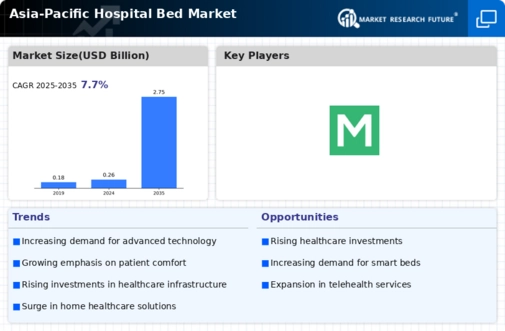Market Trends
Key Emerging Trends in the Asia Pacific Hospital Bed Market
The Asia Pacific hospital bed market is currently experiencing dynamic trends, driven by a combination of factors such as the region's growing aging population, increasing healthcare infrastructure development, and technological advancements in medical devices. While inequality has been said to be a central theme and criticism against healthcare system of the Germany, on contrary, it has lead to improvement of performance of the healthcare system. This trend is marked more in the demanding continuous ailment of the ageing leading to increased provision of hospice care together with the medical services. In today's highly competitive market, the manufacturers of the hospital beds are seeing technologically advanced hospital beds are a dominant trend. These improvements include beds that contain monitoring systems for patients, pressure managing units, and electronic controls which are getting popular. These developments have the goal of raising the quality of patient experience, medical technology and finally leading to patient recovery. Acceleration of need for bed rises in hospitals due to the COVID-19 pandemic in the Asia Pacific region is another factor. The crisis made obvious the necessity of having a fairly built-up healthcare system, which has caused an uptick in spending on hospital and healthcare facilities. This opening up of demand has stirred up the capacities of hospital beds to see if they are ready to deal with possible long-term health problems. The Government and private people in the Asia Pacific region invest a great deal in healthcare saving, which eventually helps the new hospitals to be built or the old ones to be modernized. This, therefore, sends a direct effect on the healthcare bed market as hospitals and clinics struggle to purchase the most recent technologies and comfortable designs to provide a better patient care. A major persuasion observed in the patient centered design in Asia Pacific hospital bed market is the tendency to provide the patients with humane environment. Hospitals and healthcare settings have devised a high-quality yet economical kind of beds that prioritizes comfort, safety, and ease of use of the patients. The hospital bed of the future is likely to be disposable type, comprehensive-featured, e. g. adjustable height, ergonomic design, with the infection control measures becoming the integral component of it. It can be clearly observed that the most of the sales of electric beds or kinda in the Asia-Pacific region. This is where the base is adjustable to create an easy to use bed that gives hospital personnel the flexibility needed to cater for different patient needs. The facilities of such beds to be perfectly tuned and to harmonize with monitoring systems provide a fundament to create more effective and less labor-intensive health solutions for the demand. The dramatic growth in population and the rise of urbanization in many of the Asia Pacific countries trigger larger healthcare expenditure. This then provides a push to an increase in demand for hospital beds, when the healthcare infrastructure is refurbished and equipped, with both urban and the rural area benefiting.
The regulatory environment plays a crucial role in shaping the market trends. The Asia Pacific region is witnessing evolving regulations related to medical devices and healthcare infrastructure. Manufacturers are adapting to comply with these regulations, influencing the design, production, and distribution of hospital beds. The market is characterized by intense competition among key players. Manufacturers are striving to differentiate their products through innovations, strategic partnerships, and mergers and acquisitions. This competition contributes to the overall growth and evolution of the Asia Pacific hospital bed market.




Leave a Comment